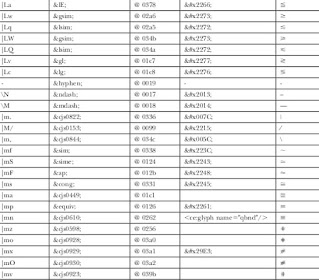HTML and XML Entity, Unicode Characters for typesetting and browsers
What is entity?
A entity is any solitary, recognizable and separate article. It alludes to people, associations, frameworks, pieces of information or even unmistakable framework parts that are considered critical all by themselves.
The term is utilized in various programming dialects/ideas, information base administration, frameworks plan and different fields.
A substance's shared factor is that it tends to be viewed as a different entire and has a remarkable arrangement of attributes.
An element is any solitary, recognizable and separate article. It alludes to people, associations, frameworks, pieces of information or even unmistakable framework parts that are considered critical all by themselves.
What is unicode Characters?
Unicode is a favored text encoding technique in programs like Google Chrome and Firefox. Unicode is likewise utilized inside in Java advances, HTML, XML, and Windows and Office.
nicode maps each character to a particular code, called code point. A code point appears as U+<hex-code> , going from U+0000 to U+10FFFF . A model code point resembles this: U+004F . ... Unicode characterizes various characters encodings, the most utilized ones being UTF-8, UTF-16 and UTF-32.
The Unicode Standard is being used today, and it is the favored person set for the Internet, particularly for HTML and XML. It is gradually being embraced for use in email, as well. Its most alluring property is that it covers every one of the characters of the world (with special cases, which will be included what's to come).
Entity and unicodes for 3B2 Typesetting:- Click here
Unicode is an all inclusive person encoding standard that doles out a code to each character and image in each language on the planet. Since no other encoding standard backings all dialects, Unicode is the main encoding standard that guarantees that you can recover or join information utilizing any blend of dialects. Unicode is needed with XML, Java, JavaScript, LDAP, and other online advancements.
The two normal Unicode executions for PC frameworks are UTF-8, a variable length encoding plan in which each composed image is addressed by a one-to four-byte code, and UTF-16, a proper width encoding plan in which each composed image is addressed by a two-byte code.
Data Builders upholds UTF-8 Unicode on the WebFOCUS Reporting Server. The presentation of Unicode into Information Builders center message taking care of offices gives its items the adaptability to help genuine multilingual message. Utilizing Unicode arranged information, WebFOCUS can create a report containing information in any mix of dialects (for instance, Japanese and French).
Why to Use Unicode?
Unicode upholds information with different scripts like French, Japanese, and Hebrew. It empowers you to join records from various contents on a solitary report. Prior to Unicode, a PC could just measure and show the composed images on its working framework code page, which was attached to a solitary content. For instance, if a PC could handle French, it couldn't deal with Japanese and Hebrew.
There is a developing pattern for all new PC advancements to utilize Unicode for text information. Notwithstanding Information Builders, Unicode has been embraced by industry pioneers like Microsoft, Apple®, HP®, IBM, Oracle®, SAP®, and numerous others. A large number of the significant information sources WebFOCUS gets to now uphold Unicode information types. The presentation of Unicode into WebFOCUS permits you to access and work straightforwardly with Unicode information and to make UTF-8 Unicode HOLD documents.
Unicode is a favored text encoding technique in programs like Google Chrome and Firefox. Unicode is likewise utilized inside in Java innovations, HTML, XML, and Windows and Office. Unicode empowers Information Builders items to consistently deal with the interface with outsider offices that utilization Unicode and are incorporated into Information Builders product offering.
Deciding if Unicode Is Necessary
Design your framework for Unicode in the event that you need to show text in disconnected contents. There might be circumstances in which Unicode gives off an impression of being the best way to absorb scripts, since you need to incorporate outsider Unicode information. Notwithstanding, much of the time, Unicode isn't the main arrangement.
For instance, on the off chance that you have Oracle information with an UTF-8 Unicode information type, yet all the text is in Japanese and English, you needn't bother with a full Unicode execution. Japanese and English are not random contents. A Japanese code page is ASCII straightforward. An ASCII-straightforward code page contains the standard English language characters, just as extra non-English characters.
Unicode is important just when consolidating text in random contents, like Japanese, French, and Hebrew. For instance, if your UTF-8 Unicode information contains Japanese text (inconsequential contents) showed on a solitary report, UTF-8 Unicode is the main arrangement. In the present circumstance, you would arrange your whole framework for UTF-8 Unicode.
Significant: Full utilization of Unicode requires cautious consideration regarding program, web worker, and working framework qualities. These attributes incorporate global language textual styles, show and print components, and information input for new scripts like Chinese, and Japanese. Carry out Unicode just in case there is a genuine business need to consolidate disconnected contents.
Unicode information can be utilized through a wide range of frameworks without information defilement. Unicode addresses a solitary encoding plan for all dialects and characters. Unicode is a typical point in the transformation between other person encoding plans.
Unicode is a person encoding standard that has far reaching acknowledgment. Microsoft programming utilizes Unicode at its center. ... They store letters and different characters by allocating a number for every one. Before Unicode was developed, there were many distinctive encoding frameworks for appointing these numbers.






No comments:
Post a Comment